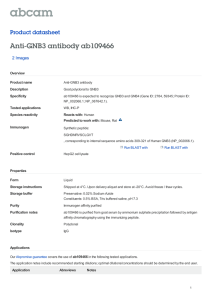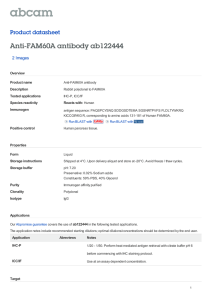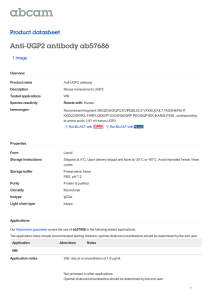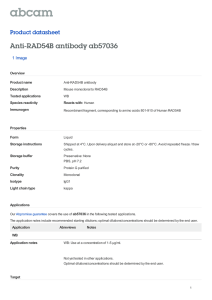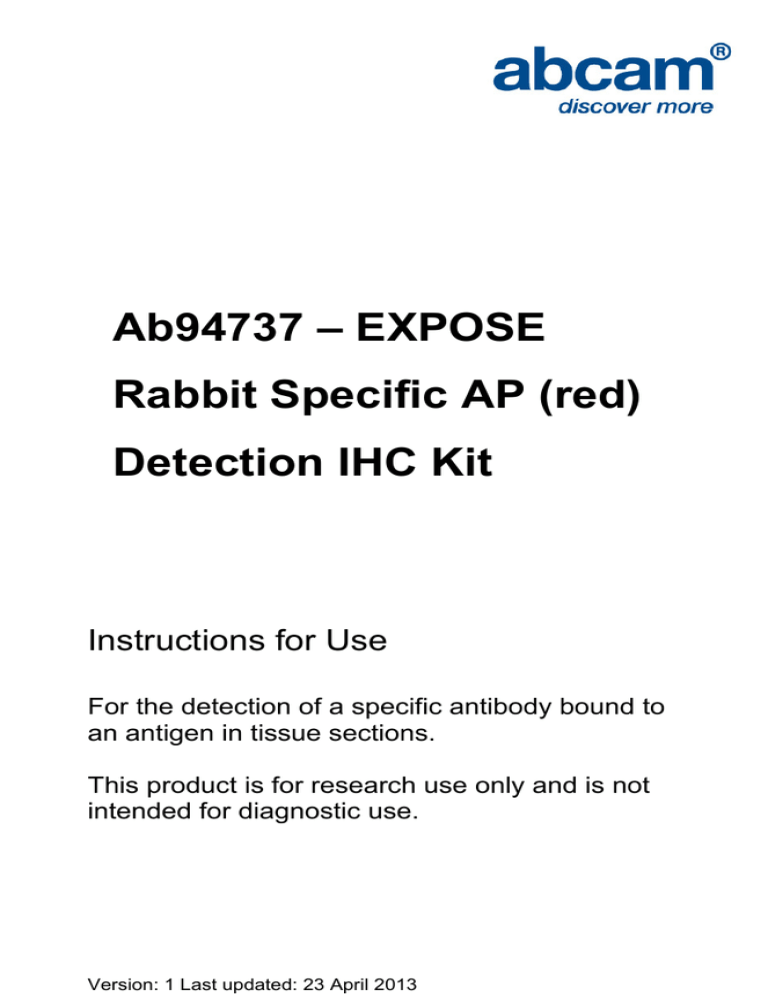
Ab94737 – EXPOSE
Rabbit Specific AP (red)
Detection IHC Kit
Instructions for Use
For the detection of a specific antibody bound to
an antigen in tissue sections.
This product is for research use only and is not
intended for diagnostic use.
Version: 1 Last updated: 23 April 2013
1
Table of Contents
1.
Introduction
3
2.
Principle of Assay
4
3.
Kit Contents
5
4.
Storage and Handling
5
5.
Additional Materials Required
5
6.
Protocol
6
7.
General IHC Troubleshooting Tips
8
2
1. Introduction
Ab94737 offers a red alternative to the brown of the DAB product for
antigen detection. This technique involves the sequential incubation
of the specimen with an unconjugated rabbit primary antibody
specific to the target antigen, a secondary antibody- AP conjugate
which reacts with the primary antibody, and AP-compatible
chromogen (Fast Red), so that a detectable signal is generated from
converting Naphthol Phosphate substrate to a red colored product at
the site where the antibody portion of the conjugate is bound to its
target.
3
2. Principle of Assay
This detection system detects a specific antibody bound to an
antigen in tissue sections. The specific antibody is located by a
secondary antibody polymerized to an enzyme. The specific
antibody, secondary antibody -enzyme complex is then visualized
with an appropriate substrate/chromogen. The advantage offered by
a micro-polymer detection system over an ABC based detection
system is that it is biotin free (ideal for studying tissue rich in
endogenous biotin e.g. kidney or brain tissue). In addition the use of
a micro-polymer detection system is advantageous over a polymer
detection system as a smaller detection complex is formed rather
than a polymer backbone aiding better tissue penetration.
Fig. 1. Comparison of EXPOSE DAB IHC detection system to
Polymer detection system
Image Notes: Detection of CDX2 on FFPE colon cancer carcinoma
tissue. Antigen retrieval performed using Citrate buffer. Primary
antibody diluted 1:100 with a 30 minute incubation.
4
3. Kit Contents
Item
Quantity
Quantity
Quantity
(15 mL)
(60 mL)
(125 mL)
Protein Block
15 mL
60 mL
125 mL
Enhancer
15 mL
60 mL
125 mL
Naphthol Phosphate
15 mL
60 mL
125 mL
Fast Red Chromogen
15 mL
60 mL
125 mL
AP-Conjugate GRI
15 mL
60 mL
125 mL
4. Storage and Handling
Store at 2-8°C. Do not freeze. The reagents must be returned to the
storage conditions identified above immediately after use.
5. Additional Materials Required
Primary antibody
5
6. Protocol
All steps are performed at room temperature.
Note: The inclusion of negative controls will aid in accurate
interpretation of the staining results and help in determining false
positives. Negative control fixed and processed in the same manner
as the tissue specimen placed on every slide run, during manual or
automated staining, in addition to the target tissue is strongly
recommended. For the test to be considered valid, the negative
control should be clean. This negative tissue control should be
included to ensure that the other treatment procedures did not create
false positive staining.
Staining Protocol
1. Deparaffinize and rehydrate formalin-fixed paraffin-embedded
tissue section.
2. Perform appropriate pretreatment if required. Wash 3 times in
buffer.
3. Apply Protein Block and incubate for 10 minutes at room
temperature to block nonspecific background staining. Wash 1
time in buffer.
4. Apply
primary
antibody
and
incubate
according
to
manufacturer’s protocol.
6
5. Wash 3 times in buffer. Apply AP-conjugate and incubate for 1530 minutes. Wash 4 times in buffer.
6. Rinse 4 times in buffer. Apply 200 μL of Enhancer and incubate
for 4 minutes. DO NOT RINSE OFF.
7. Mix equal volume of Naphthol Phosphate and Fast Red just
before using, apply 200 μL onto the slides with Enhancer. The
recommended incubation time is 8 minutes at room temperature,
however the incubation can be stopped earlier by washing the
slide in buffer.
8. Optional: If there is not enough red color developed, add another
100 μL of the Fast Red chromogen and incubate for 4 more
minutes.
9. Rinse 4 times in buffer. Counterstain according to the
manufacturer’s protocol.
10. Rinse 7-8 times in tap water.
Add an aqueous Mounting
Medium to cover the section, or let the slides dry in an oven at
50-60°C for at least 30 minutes before dipping in xylene twice
and mounting.
The specificity and sensitivity of antigen detection is dependent on
the specific primary antibody used.
7
7. General IHC Troubleshooting Tips
Problem
Cause
Solution
No
The primary antibody and
Use secondary antibody that
Staining
the secondary antibody are
was raised against the species
not compatible.
in which the primary was
raised (e.g. primary is raised in
rabbit, use anti-rabbit
secondary).
Not enough primary
Use less dilute antibody,
antibody is bound to the
Incubate longer (e.g.
protein of interest.
overnight) at 4°C.
The antibody may not be
Test the antibody in a native
suitable for IHC procedures
(non-denatured) WB to make
which reveal the protein in
sure it is not damaged.
its native (3D form).
The protein is not present in
Run a positive control
the tissue of interest.
recommended by the supplier
of the antibody.
8
The primary/secondary
Run positive controls to ensure
antibody/amplification kit
that the primary/secondary
may have lost its activity due
antibody is working properly.
to improper storage,
improper dilution or
extensive freezing/thawing.
The protein of interest is not
Use an amplification step to
abundantly present in the
maximize the signal.
tissue.
The secondary antibody was
Always prevent the secondary
not stored in the dark.
antibody from exposure to
light.
Deparaffinization may be
Deparaffinize sections longer,
insufficient.
change the xylene.
Fixation procedures (using
Use antigen retrieval methods
formalin and
to unmask the epitope, fix for
paraformaldehyde fixatives)
less time.
may be modifying the
epitope the antibody
recognizes.
9
The protein is located in the
Add a permeabilizing agent to
nucleus and the antibody
the blocking buffer and
(nuclear protein) cannot
antibody dilution buffer.
penetrate the nucleus.
The PBS buffer is
Add 0.01% azide in the PBS
contaminated with bacteria
antibody storage buffer or use
that damage the phosphate
fresh sterile PBS.
groups on the protein of
interest.
10
Problem
Cause
Solution
High
Blocking of non specific
Increase the blocking
Background
binding might be absent or
incubation period and
insufficient.
consider changing
blocking agent. Abcam
recommends 10% normal
serum 1hr for sections or
1-5% BSA for 30 min for
cells in culture.
Incubation temperature may
Incubate sections or cells
be too high.
at 4°C.
The primary antibody
Titrate the antibody to the
concentration may be too
optimal concentration,
high.
incubate for longer but in
more dilute antibody (a
slow but targeted binding
is best).
The secondary antibody may
Run a secondary control
be binding non-specifically
without primary antibody.
(damaged).
11
Tissue not washed enough,
Wash extensively in PBS
fixative still present.
between all steps.
Endogenous peroxidases
Use enzyme inhibitors i.e.
are active.
Levamisol (2 mM) for
alkaline phosphatase or
H2O2 (0.3% v/v) for
peroxidase.
Fixation procedures (using
Change antigen retrieval
formalin and
method, decrease the
paraformaldehyde fixatives)
incubation time with the
are too strong and modified
antigen unmasking
the epitope the antibody
solution.
recognizes.
Too much amplification
Reduce amplification
(amplification technique).
incubation time and dilute
the amplification kit.
Too much substrate was
Reduce substrate
applied (enzymatic
incubation time.
detection).
12
The chromogen reacts with
Use Tris buffer to wash
the PBS present in the
sections prior to incubating
cells/tissue (enzymatic
with the substrate, then
detection).
wash sections/cells in Tris
buffer.
Pemeabilization has
Remove permeabilizing
damaged the membrane and
agent from your buffers.
removed the membrane
protein (membrane protein).
13
Problem
Cause
Solution
Non-
Primary/secondary antibody
Try decreasing the
specific
concentration may be too high.
antibody concentration
staining
and/or the incubation
period. Compare signal
intensity against cells that
do not express the target.
Endogenous peroxidases are
Use enzyme inhibitors i.e.
active.
Levamisol (2 mM) for
alkaline phosphatase or
H2O2 (0.3% v/v) for
peroxidase.
The primary antibody is raised
Use a primary antibody
against the same species as
raised against a different
the tissue stained (e.g. mouse
species than your tissue.
primary antibody tested on
mouse tissue). When the
secondary antibody is applied
it binds to all the tissue as it is
raised against that species.
The sections/cells have dried
Keep sections/cells at
out.
high humidity and do not
let them dry out.
14
UK, EU and ROW
Email: technical@abcam.com | Tel: +44-(0)1223-696000
Austria
Email: wissenschaftlicherdienst@abcam.com | Tel: 019-288-259
France
Email: supportscientifique@abcam.com | Tel: 01-46-94-62-96
Germany
Email: wissenschaftlicherdienst@abcam.com | Tel: 030-896-779-154
Spain
Email: soportecientifico@abcam.com | Tel: 911-146-554
Switzerland
Email: technical@abcam.com
Tel (Deutsch): 0435-016-424 | Tel (Français): 0615-000-530
US and Latin America
Email: us.technical@abcam.com | Tel: 888-77-ABCAM (22226)
Canada
Email: ca.technical@abcam.com | Tel: 877-749-8807
China and Asia Pacific
Email: hk.technical@abcam.com | Tel: 108008523689 (中國聯通)
Japan
Email: technical@abcam.co.jp | Tel: +81-(0)3-6231-0940
www.abcam.com | www.abcam.cn | www.abcam.co.jp
Copyright © 2013 Abcam, All Rights Reserved. The Abcam logo is a registered
trademark. All information / detail is correct at time of going to print.
15


